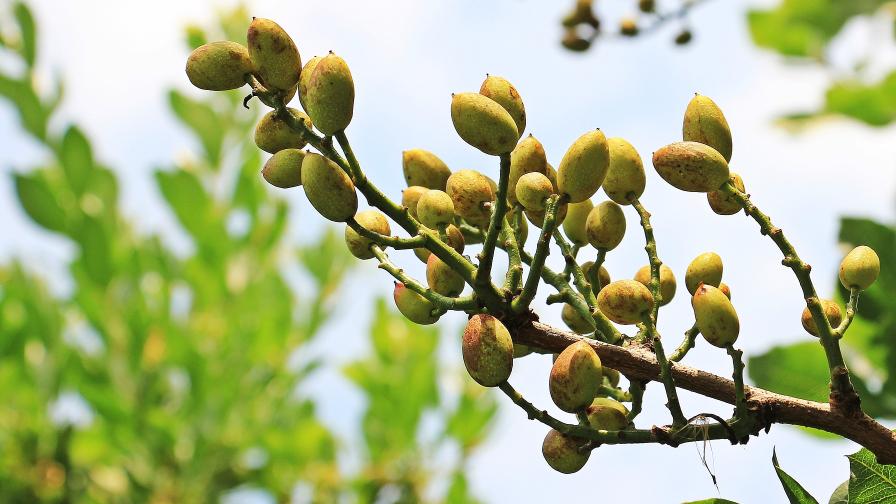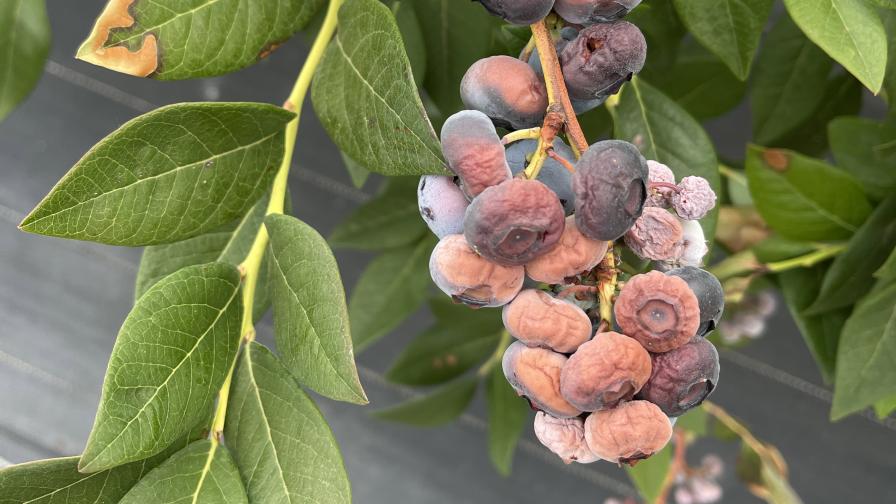Historic Heat Wave Still Has PNW Berry Growers Feeling the Burn

In more than three decades as a berry crops researcher with Oregon State University, Dr. Bernadine Strik had never seen such stress put on plants and fruit than by the extreme heat wave that baked the Pacific Northwest earlier this year.
Photo courtesy of Oregon State University
Bernadine Strik didn’t need her three decades of toiling in Oregon berry fields to realize something was very wrong. She didn’t even have to open her eyes.
“When you walked through a blackberry field the day we got heat damage, it was like smelling a blackberry sauce you had left on the stove too long to cook,” she says. “It was that kind of an overcooked, gooey-sweet smell. It was nasty.”
Nastier yet, this was only the start. The Pacific Northwest (PNW) heat wave of 2021 wound up lasting so long, from late June to mid-July, that weather experts later termed it a heat dome. Triple-digit temperatures (up to 118°F in Oregon and Washington) “just sat over the region,” Strik says.
In many cases, the ensuing damage to crops was immediate. “Heartbreaking,” Strik says. In other instances, growers won’t face the last of ramifications until as late as the 2022 growing season.
“It’s so complicated,” she says. “And it’s scary for growers and for the industry. The unknown is scary.”
Strik is in her 34th and final year as a teacher, researcher, and Extension agent with Oregon State University (OSU). One of the nation’s leading authorities on berry growing, she will retire Dec. 31.
“It’s time,” she says, citing a desire to spend more time with her husband and family. That her final two seasons have been marked by COVID-19 and what some are calling a “once in a millennium” weather event is coincidental but not discounted. “I thought 2020 was bad,” she says. “Then we start 2021, and this happens.”
Saturday, June 26, began ordinarily enough with a morning low of 66°F outside OSU’s North Willamette Research and Extension Center (NWREC) in Northwestern Oregon. But the temperature would soon rise to 106°F, unusually hot for the season. Equally alarming to plant health was the low humidity —only 13% to 16% during the hottest part of the day.
The following day’s temperatures ranged from 71°F to 111°F. By Monday, after a morning low of 85°F (hotter than the aver-age daily high), the temperature topped out at 113°F at the research center and 117°F in nearby Salem, OR, where, Strik notes, there are a lot of blueberry farms.
“The straw that broke the camel’s back,” she recalls.
BERRY BREAKDOWNS
The extent of the ensuing damage to all types of berries differed depending on when a specific crop —or a variety within a crop —ripens and how it adapts to heat. For instance, strawberry, cranberry, and kiwiberry dodged harm, Strik says, because of their early or late harvests.
Damage to blueberries ran the gamut depending on cultivar. The earliest ripening variety, ‘Duke’, started to harvest as early as June in various locations. In turn, some growers, Strik says, had already picked once before the heat struck.
“So that fruit is of exceptional quality,” she says.
To the contrary, ‘Aurora’, a “very sensitive” cultivar, Strik notes, experienced 100% loss on some farms because it normally fruits in late August.
“All of the green fruit —and the fruit was green —all of it torched,” she says. “And a lot of the leaves torched. It’s a variety that is very sensitive to these types of heat conditions.”
As for other berry crops in Oregon:
Black Raspberry: Strik estimates that 80% of the crop —which was at prime ripeness during the heat wave —was lost.
The toll was significant, she adds, considering Oregon is the world’s leading black raspberry production region.
Red Raspberry: Growers experienced 60% to 70% damage, Strik says, “which is certainly not inconsequential.”
Trailing Blackberry: Oregon boasts 6,000 acres of the crop. Depending on the variety, damage ranged from 50% to 100%. “There are growers who lost their entire crop,” Strik says.
With 13 acres of her own berry research trials at the NWREC facility, Strik empathizes with all PNW growers. “We were scrambling to harvest as much fruit as we could that was ready to harvest before the forecasted heat event,” she says. “Labor availability, due to the pandemic, is tougher. And the trouble is you can’t machine harvest a blackberry crop until it’s ready to machine pick. It won’t come off. Growers were strapped.”

‘Black Diamond’ trailing blackberry on west side of row shows symptoms of heat damage on fruit and leaves.
Photo by Bernadine Strik
Now, the industry is left wondering what might have been.
“We were going into the season with beautiful fields and very high yield potential. All signals were that we were going to get a tremendous berry season,” Strik says. “And it broke my heart because I know the growers had put all this investment into getting these fields looking so good.”
MOVING FORWARD
The true economic impact of the heat dome won’t be determined until next spring, Strik says.
“What I’m telling growers to think about, especially in blueberry, is the added cost of pruning. We liter-ally have dead wood in bushes in some varieties that were really hit hard. When all of the leaves scorch, the shoot dies,” she says. Those scorched leaves may also impact flower bud development for next year’s crop, Strik adds. “That is something we’re waiting to see.”
Until then, best practices are already beginning to take shape in the wake of the heat dome and with consideration toward climate change and similar weather events.
Dual Irrigation Systems: A fairly large number of blueberry growers nationwide —and a smaller proportion in Oregon —use dual irrigation systems, Strik says. Drip irrigation allows for fertigating, while overhead systems with micro-sprinklers protect against frost or provide evaporative cooling.
“We’ve done research here in Oregon and Eastern Washington to show that running an evaporative cooling system for 20 minutes every hour —20 minutes on, 40 minutes off —can mitigate heat damage at temperatures above 95°F,” Strik says, “So, most growers who had evaporative cooling systems in blueberries had very little damage.” However, Strik estimates that currently less than 25% of the 15,000 blueberry acres in Oregon currently have the capability to use evaporative cooling.
“The challenge is that many growers are very large —200 acres plus. They just don’t have the pumping capacity to be able to rotate that fast through all their acreage. So, they’d focus on the most susceptible varieties first,” Strik says. “Unfortunately, because dual systems are rather expensive, and, prior to what even the industry is calling this unprecedented climate change effect of this heat dome, they have not needed them. Frost injury in the Willamette Valley, which is our leading production region, is rare. And needing evaporative cooling for temps above 95°F during the fruit development period is also rare —until this year.”
Heat-Tolerant Varieties: Caneberry growers could consider transitioning to varieties that are more heat tolerant if they are convinced similar heat waves are forthcoming.
“That has a huge cost because you’re replanting a perennial crop,” Strik says. “But the added piece is we noticed a lot of variability in the breeding of advanced selections that we have at the research station. It’s a longer-term approach, but breeding for greater heat tolerance is certainly a possibility in the caneberries.”
Misting Systems: While 90% of the Oregon caneberry industry grows for processing, the limited amount of fresh market growers can turn to misting systems to reduce heat damage. On the downside, this increases the risk of rot, Strik says.
Grass Rows: Fields with grass between the rows have a higher humidity than those that have soil between the rows, Strik says.
“Now that only works if the grass isn’t dormant, and in most drip-irrigated fields the grass is dormant,” she says. “But in caneberry growing fields where they use overhead irrigation, they might consider putting in grass.”
Shade Netting: In some regions, such as Eastern Washington, growers use overhead shade netting on some of their ‘Dukes’, Strik says, because it gives them a broader growing season.
“But it actually helps them during this heat wave because there is less incidental light and it cools the plant somewhat,” she says. “But it’s not practical here in Oregon, especially when you’re looking at needing a shade structure that will allow machine harvest.”
What growers in the PNW could use more than anything, Strik says, is disaster relief. She has done her part by detailing the heat damage in letters addressed to the Oregon Raspberry and Blackberry Commission (ORBC) and Oregon Blueberry Commission (OBC). The letters have been shared with U.S. Secretary of Agriculture Tom Vilsack, Governor Kate Brown, and state representatives, all of whom have visited local berry fields to assess the situation.
“State help, federal help, whatever,” Strik says. “None of the damage that I saw in any fields was through any fault of the grower. It was simply a weather event that they could do nothing about. And that’s just heartbreaking. This was just a bad, new experience.”












